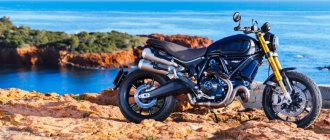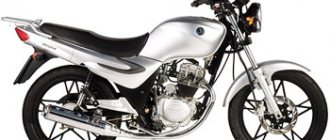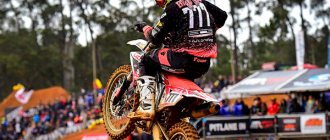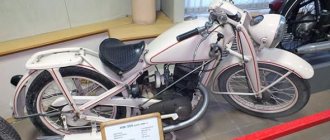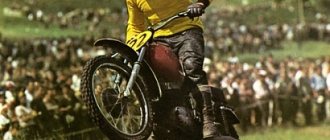The history of motorcycling, as we have already found out, dates back almost to the very invention of the motorcycle, that is, from 1885. The emergence of such a popular discipline as motocross to this day is almost inextricably linked with it, since it became one of the first official directions, which, moreover, was even able to give rise to a number of other spectacular disciplines.
Motocross in a nutshell
In modern terms, motocross (also sometimes referred to as MotoX or simply MX) is a race on a closed track that runs over rough terrain off public roads. The main task of each racer is to be the first to complete a certain number of laps in the allotted time. In professional races it is usually limited to 30 minutes plus 1-2 additional laps.
Unlike other sports, where high speed is at the forefront, the physical preparation and skill of the racers are no less important here, since they have to overcome a large number of different obstacles on the way to the finish line. These include changes to the road surface to dirt and sand, steep ascents and descents, and even artificially installed small jumps. All this makes motocross one of the most spectacular and therefore popular competitions. However, it was not always this way.
New country - new sport
In the 1970-80s, Soviet motorcycle sport was already a full-fledged professional field with its own achievements and stars, which had practically nothing in common with the amateur competitions that became its basis at the very beginning of the century. However, already in 1991, the Russian Federation replaced the Soviet Union, the place of the FMS of the USSR was taken by the MFR (Motorcycle Federation of Russia), which became a full member of the FIM in 1992, and the history of domestic motorcycle sports took another turn, which we will definitely talk about in future materials.
Where it all started
The so-called “fox racing” is considered to be the ancestor of motocross. This competition was organized in England in 1908 with the aim of proving that motorcycles, despite their relative youth, are a very promising means of off-road transportation, superior in power and cross-country ability to horses common at that time. To confirm this, 16 riders and 13 motorcyclists took to the track.
Fans of innovation failed to prove that they were right: firstly, the cavalry won an unconditional victory in time in the race, and, secondly, 11 of the racers in “mechanized carriages” were not able to reach the finish line at all. But, despite the defeat, motocross, together with motorcycle technology, continued its development and within a few years appeared before the audience in a new guise.
Here it is worth moving away from the topic and noting that the main type of competition at that time was long-distance racing. They posed a serious challenge to the racers, who were often also engineers who manually modified their “iron horses,” but were of little interest to the spectators: it was simply impossible to follow the movement along the entire length of the track. Therefore, the first attempts were made to make the competitions more local, so that their visitors could see the complexity of the athletes’ struggle. One of these attempts was a new prototype of motocross.
In truth, he had virtually nothing to do with what he ended up becoming. The fact is that the competition was not held on the usual closed track, but at the foot of the hill. The main task of the participants, who started one after another, was to climb to the top, but due to the low power, the considerable weight of the motorcycles of those years and the steepness of the climb, no one was able to do this. The winner was the racer who managed to get closest to the goal. It’s easy to guess that with such rather strange rules, the competition was not a resounding success.
Once again, and this time for good, motocross returned after World War II. The rules changed again and now represented the familiar cross-country race with the simultaneous start of all participating motorcyclists. The only controversial point was the length of the route, which was ultimately limited to 1.5-3 km. However, there were exceptions to this rule - sometimes the length of the ring reached an impressive 30 km, and if there was a large number of participants, participants could start one by one. However, such changes only diversified the accepted concept and made the newly formed competitions even more interesting for a simple, uninitiated viewer.
Pavel KOSOLAPOV and from the archives of veterans
—Sunday summer day 1941, Moscow motocross championship. The competition is in full swing, and intense competition has broken out on the track. The athletes drive up to the next checkpoint to make a mark on a piece of paper, and then, holding it in their teeth, continue the race... But the controller is not there. In complete bewilderment they head towards the finish line. “The competition is canceled - war...” So for the participants in that race another struggle began, harsh and dangerous. The main prize for the winners is life. And already on June 27, 1941, at the Dynamo stadium, the first detachments of the Separate Special Purpose Motorized Rifle Brigade (OMSBON) were formed from volunteer athletes. Motocross riders who participated in that last pre-war championship joined its ranks. The brigade's tasks included carrying out special missions to provide communications, organizing reconnaissance and sabotage operations behind enemy lines, eliminating enemy agents, and assisting the partisan movement. Almost always this meant the risk of getting shot. Now each of those front-line racers is already well over 80. However, there are only a few “everyone” left. Three of them told Moto readers about the war days. Gennady FOMIN, master of sports in motocross, honored coach of the USSR, former coach of the national team, international judge, honorary vice-president of the International Motorcycle Federation, retired lieutenant colonel, OMSBON veteran:
“I learned about the beginning of the war at those same competitions and the very next day I went to the military registration and enlistment office. But they refused me - my year for conscription had not yet come. I read in Pravda that a special team of athletes is being formed at the Dynamo stadium. Together with a friend, the famous rower Alexander Lavrushin, he went to sign up as a volunteer. And here they took me! In addition to the athletes, the brigade included a battalion of Spaniards who came to the USSR after the revolution in their country. We, recruits, were sent to the Moscow region to master military skills, subversive activities, and conduct sabotage operations.
We returned to Moscow in mid-October 1941. The situation in the city is unimaginable: many are in a panicked mood, the evacuation has not yet ended, and the enemy is already in Kryukov... We were preparing for the defense of the capital, for street battles. The brigade approached the Kremlin. The squad I commanded occupied the first floor of GUM, just opposite the Mausoleum. They ordered: tanks will appear - open fire, first of all, disable the equipment. But the tanks did not enter the city. Only once did a plane break into the airspace of Moscow, one of the bombs hit the Kremlin... A little later, army units of the Siberians arrived, ensuring the defense of the city.
Soon I transferred to a motorcycle company. There was a company, but no motorcycles. We were ordered to search for the equipment and confiscate it. There was practically no need to confiscate motorcycles from citizens in favor of the army - many captured motorcycles were acquired after the defeat of the Nazis in Kryukov. Our main job was to maintain contact with the advanced units - after all, the wires of the transmission lines were torn. So we were sent for information, to forward orders, to clarify the disposition of formations and individual units. We tried not to engage in open battle in vain - the information we were carrying was much more important. And how can you shoot if your hands are holding the steering wheel?
Officers were also taken to the front line. One day I was carrying a colonel in a carriage, when suddenly - the Germans! They blocked the road and opened fire. It was at a time when the ground was covered in snow, and they were wearing white camouflage suits - you couldn’t tell how many of them there were, where they were firing from…. I told the colonel: “Get down!” - and gas to the limit!.. When they escaped, drove to a safe distance and stopped, I looked - the carriage was all full of holes from bullets, but not a single one hit me or the colonel.
Then I was sent to a special detachment in the Caucasus, where my other hobby came in handy - mountaineering. There’s no time for motorcycles in the mountains—he fought differently here...
Motocross in the USSR and reaching the world level
Initially, like any other discipline, all competitions were amateur and semi-amateur in nature, but after the basic rules were determined, they quickly received the official status of a full-fledged sports discipline. Even in the USSR, which was quite far behind France and England, the pioneers of motorcycle sports, already in 1928, the first official cross-country race was organized, which became part of the Olympics. However, at that time the distance chosen was much longer than is customary now - its length reached 100 km.
In general, during this period motocross in the USSR can easily be called the most popular type of motorcycle sport. Races were held not only in large cities, but also in regions and were often tied to certain memorable dates and historical figures.
All this ultimately led first to the holding of the first international competitions in 1954, and then to the participation of Soviet athletes in the World Championships. By the way, it was first held in 1957, replacing the European Championship held since 1952, and since then it has remained the main world-class competition.
News
The combination of cross-country motorcycle riding and speed was the impetus for the emergence of motocross competition. One of the first cross-country competitions open to the public was the so-called "fox race", held at a military training ground near London in 1908. It involved 13 motorcyclists and 16 horse riders. The goal of the motorcyclists was to prove that the new off-road technology was faster than horses. However, it was the cavalrymen who won the race, and only two of the motorcyclists finished the competition.
In subsequent years, motocross events continued to be held in the UK and France, but they did not arouse public interest - there was a lack of visibility. For the first cross-country races, one of the elements of the multi-day race was used - hill climbing. The start was single, not mass, the route was chosen so that not a single rider could reach the top, and the winner was the one who could cover the greatest distance. It was only after the First World War that the most successful form of motocross racing was found in European countries. They began to be carried out on natural terrain with grassy, sandy or even mud (but without stones) surface, using a mass start.
Disputes about the length of one lap of the distance ended in favor of fairly short tracks - 1.5-3 km - as more spectacular for spectators and safer for the racers themselves. However, in the USSR and the USA motocross races were held with a lap length of 30 km or more. This was due to the massive nature of motocross competitions - there were so many riders taking part in the race that they could not fit on the track without interfering with each other.
The official recognition of motocross in the USSR is considered to be the first All-Union Workers' Spartakiad, held in 1928. Her program included a 100 km motocross race. In 1936, the USSR motorsport championship took place in Kyiv. In 1957, motocross was held for the first time in Rastorguevo on a short track of 1.3 km in three races of ten laps.
Cross motorcycles
The first motocross competitions were attended by riders on road motorcycles, adapted to travel over rough terrain under their own power. Motorcycles were made lighter by removing parts unnecessary for competition - headlights, brake lights, trunk, passenger footrests, mirrors, the suspension was modified, and engine power was increased.
The advent of serial motocross motorcycles led to evolutionary changes in design. The original very wide handlebars, designed to increase leverage, have been reduced, and the travel of the fork and swingarm has been increased. The exhaust pipes located below began to be raised to prevent damage from falls].
Lightening the engine and simultaneously increasing its power led to the fact that the fairly common but heavy 4-stroke engines were replaced by light, high-revving, easy-to-manufacture 2-stroke engines. The engines became exclusively single-cylinder. The advent of cross-country tires made it possible to radically improve the handling of a motorcycle[7]. The electric starter was replaced with a kickstarter, and the battery was eliminated.
In the 80s, these innovations marked the beginning of the modern design of a cross-country motorcycle [7]: the seat now seemed to float over the tank, which made the rider’s movements on the motorcycle more comfortable; The heavy and ineffective drum brake was replaced by a disc brake, which completely replaced the old system by the mid-90s; the most important changes affected the suspension - a progressive suspension with a monoshock absorber made it possible to increase the pendulum stroke, reduce weight and, although it was somewhat more complicated, still made the shock absorber work adequately in all modes; Another significant change in the 80s was the advent of water cooling, which replaced air cooling.
Further innovations were also associated with a reduction in sprung masses and led to the appearance of an inverted front fork, which made it possible to greatly improve the performance of the front suspension at modern speeds. The advent of new alloys and materials has made it possible to introduce new changes that improve the ride quality and power of motorcycles. In the late 90s, due to tightening environmental standards, 4-stroke engines reappeared on the market - the latest developments have made such engines quite lightweight and reliable.
Thus, modern serial motocross motorcycles have long suspension travel - 300 mm or more, a powerful engine and a lightweight frame[8]. According to the type of operating process, engines can be two-stroke (2T) or four-stroke (4T)[9]. They do not have lighting equipment, mirrors, dashboard, or side support. Most often they do not have an electric starter.
However, for example, in 2011, the electric starter was returned to the KTM motocross line of motorcycles.
Cross-country motorcycles are not registered with the traffic police, since they are not certified for travel on public roads and cannot have a title or license plate. A driver's license is not required to drive a motocross motorcycle, as it is a sports equipment.
Children's motocross motorcycles
Children's motocross motorcycles are usually divided into motorcycles for beginners, designed to gain first off-road riding skills, and motorcycles already classified as sports equipment. Beginner motorcycles may have a semi-automatic or automatic transmission.
Children's motocross motorcycles should be distinguished from pit bikes. Pit bikes are designed so that an adult can ride them; they have an extended wheelbase. The children's motocross motorcycle is made especially for the child. The child should be able to place both feet comfortably on the ground while sitting in the saddle and be able to easily reach the controls
Motocross in the USSR
During Soviet times, motocross was one of the most popular types of motorcycle sports. Competitions were held, starting with the championship of districts and cities and ending with the championship of the Soviet Union. Often motocross events were dedicated to significant people or events. For example, motocross in memory of Yuri Gagarin - in Saratov, in memory of Fyodor Poletaev - in Ryazan, in memory of Vladimir Kurylenko - in Smolensk, in memory of Zoya and Alexander Kosmodemyansky - in Tambov, in memory of the Young Guard - in Krasnodon, in memory of Tsiolkovsky - in Kaluga, etc.
In 1954, the USSR hosted its first international motocross competitions. The two-day race took place in the Planernaya area near Moscow. Czechoslovak, Polish, German (GDR) and Soviet racers took part in it. Subsequently, international motocross races began to be held annually in the USSR.
In 1956, the Central Automoto Club of the USSR became members of the FIM, and riders from the USSR were able to take part in the world motocross championships.
In 1963, racer Igor Grigoriev won third place in the 250 cm3 class and was the first Soviet racer to be awarded an FIM bronze medal.
In 1964, Viktor Arbekov won third place. And in 1965, he was the first Soviet rider to win the motocross world champion title, defeating six-time world champion in the 250 cm3 class, Belgian Joel Robert.
In 1968, in Chisinau, the FIM and the Central Automobile Club of the USSR held the “Motocross of Nations” (English) Russian. — team cross-country competition on motorcycles of the 500 cm3 class. The first place is won by the USSR, second by the GDR, third by France, fourth by Romania, fifth by Finland and last by Switzerland.
In 1973, Soviet athletes won third place in the Motocross of Nations and second place in the Trophy of Nations.
In 1974, racer Gennady Moiseev became the world cross-country champion on 250 cm3 motorcycles.
In 1978, Soviet riders took second place in the Trophy of Nations competition.
For ideological reasons, the use of equipment from Western countries was prohibited in the USSR, so athletes could participate in races only on motorcycles produced in the Soviet Union and socialist countries, in particular Czechoslovakia (CZ and Jawa motorcycles). However, at one stage of the 1973 World Championship, Moiseev’s CZ motorcycle was not delivered on time, and then the Austrians offered to ride this stage on a KTM. Gennady Moiseev accepted the offer and won the race. With KTM, Gennady Moiseev became three times world champion in 1974, 1977 and 1978.
In 1979, another ban was imposed on the use of equipment from Western countries in competitions, which negatively affected the results of Soviet cross-country athletes
Motorcycle Features
Along with the rules, the equipment used in competitions also changed. Initially, these were ordinary production motorcycle models. A little later, when motocross began to take on more modern forms, it became clear that such motorcycles were too heavy and clumsy for quick, confident maneuvering on difficult tracks, so riders began to modify them themselves, getting rid of everything “extra” (headlights, trunk) and modifying them chassis.
A little later, when the industry stepped forward, the first production models, originally intended for cross-country racing, began to appear. All changes made to them were based on observations of the behavior of cars and racers on the track. In addition to the general lightweighting of the design, they also reduced the width of the steering wheel, which made the car more controllable, increased the travel of the fork, and also raised the exhaust pipe, which previously was constantly damaged. But the most important change was related to the engine: the common but heavy 4-stroke engines were replaced by more compact, lighter and faster 2-stroke single-cylinder engines, making the entire design much more manageable and lighter.
Modern production models of cross-country motorcycles continue these ideas: they lack a battery and an electric starter (at least in most models it is replaced by a kickstarter), headlights, brake lights, mirrors and a dashboard. In addition, due to the use of more modern alloys and a number of technological solutions, for example, the abandonment of a drum brake in favor of a disc brake, their design was made even more lightweight. This allowed the re-installation of 4-stroke engines.
Now all motorcycle models are divided into classes according to engine capacity: 50, 65, 85, 125, 350 and 500. For obvious reasons, competitions are held between cars of the same class.
Motocross as a ancestor for other sports
And the last thing worth dwelling on is the influence of motocross on the entire motorcycle sport as a whole, which, due to its early appearance and receipt of the status of an official sport, was almost inevitable. In particular, the cross served as the ancestor for several other areas at once:
- Supercross is almost a complete analogue of the “big brother”, but held in small stadiums and even indoors. The length of the track does not exceed 400 meters, and the number of participants has been reduced from 40 to 25.
- Supermoto is racing on tracks that include asphalt and dirt sections. Initially, motocross motorcycles were used for them, capable of accelerating with equal success on various surfaces, but now they have given way to specially designed models.
- Freestyle motocross is one of the youngest (officially adopted by the FIM in 2005) type of motorcycle sport, which consists of long jumps on a motorcycle from a high springboard with the rider performing acrobatic stunts in flight. Just as in the case of supermoto, he initially used cross-production models, which later began to be modernized to meet new requirements.
Production leaders
Today, the world market has finally decided on the top list of companies producing motocross equipment. Of the five leaders, four are from Japan.
These are Suzuki, Kawasaki, Honda and Yamaha. But this does not mean that the rest of the world is standing on the sidelines, just watching the race of leaders. A Honda or Yamaha motocross motorcycle is the dream of any modern racer.
From Europe, it is worth noting such companies as BMW (Husqvarna is now part of the concern), Aprilia (Italy), Ossa (Spain), Praga (Czech Republic).
Unfortunately, the already legendary Zundapp and DKW are not on this list. The first company was abolished in the 80s and went to the Chinese, and the second ceased to exist in 1966.
These motocross motorcycles, photos of which adorn motorsports museums, have now become an example for many manufacturers.

